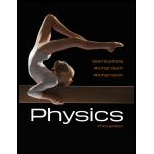
(a)
The speed of the ship travelling according to an Earth observer.
(a)
Answer to Problem 67P
The speed of the ship travelling according to an Earth observer is
Explanation of Solution
The time elapse between the two events is
Let us use the symbols with primes for the astronaut’s frame and symbols without primes for the Earth’s frame. Earth measures the proper time between the events since they occur at the same location in that frame so that
Write the expression for the contracted length in the Earth’s frame.
Here,
Write the expression for the speed of the ship measured in the Earth’s frame.
Here,
Use equation (I) in equation (II).
Rearrange the above equation,
Write the expression for the Lorentz factor.
Here,
Conclusion:
Substitute
Use equation (V) and (VI) in equation (IV)and solve for to
Therefore, the speed of the ship travelling according to an Earth observer is
(b)
The elapsed time between light flashes in the astronaut’s frame of reference.
(b)
Answer to Problem 67P
The elapsed time between light flashes in the astronaut’s frame of reference is
Explanation of Solution
The clock measures the proper time interval
Write the expression for the time dilation.
Here,
Use equation (V) in equation (VII),
Conclusion:
Substitute
Therefore, the elapsed time between light flashes in the astronaut’s frame of reference is
Want to see more full solutions like this?
Chapter 26 Solutions
Student Solutions Manual for Physics
 College PhysicsPhysicsISBN:9781305952300Author:Raymond A. Serway, Chris VuillePublisher:Cengage Learning
College PhysicsPhysicsISBN:9781305952300Author:Raymond A. Serway, Chris VuillePublisher:Cengage Learning University Physics (14th Edition)PhysicsISBN:9780133969290Author:Hugh D. Young, Roger A. FreedmanPublisher:PEARSON
University Physics (14th Edition)PhysicsISBN:9780133969290Author:Hugh D. Young, Roger A. FreedmanPublisher:PEARSON Introduction To Quantum MechanicsPhysicsISBN:9781107189638Author:Griffiths, David J., Schroeter, Darrell F.Publisher:Cambridge University Press
Introduction To Quantum MechanicsPhysicsISBN:9781107189638Author:Griffiths, David J., Schroeter, Darrell F.Publisher:Cambridge University Press Physics for Scientists and EngineersPhysicsISBN:9781337553278Author:Raymond A. Serway, John W. JewettPublisher:Cengage Learning
Physics for Scientists and EngineersPhysicsISBN:9781337553278Author:Raymond A. Serway, John W. JewettPublisher:Cengage Learning Lecture- Tutorials for Introductory AstronomyPhysicsISBN:9780321820464Author:Edward E. Prather, Tim P. Slater, Jeff P. Adams, Gina BrissendenPublisher:Addison-Wesley
Lecture- Tutorials for Introductory AstronomyPhysicsISBN:9780321820464Author:Edward E. Prather, Tim P. Slater, Jeff P. Adams, Gina BrissendenPublisher:Addison-Wesley College Physics: A Strategic Approach (4th Editio...PhysicsISBN:9780134609034Author:Randall D. Knight (Professor Emeritus), Brian Jones, Stuart FieldPublisher:PEARSON
College Physics: A Strategic Approach (4th Editio...PhysicsISBN:9780134609034Author:Randall D. Knight (Professor Emeritus), Brian Jones, Stuart FieldPublisher:PEARSON





